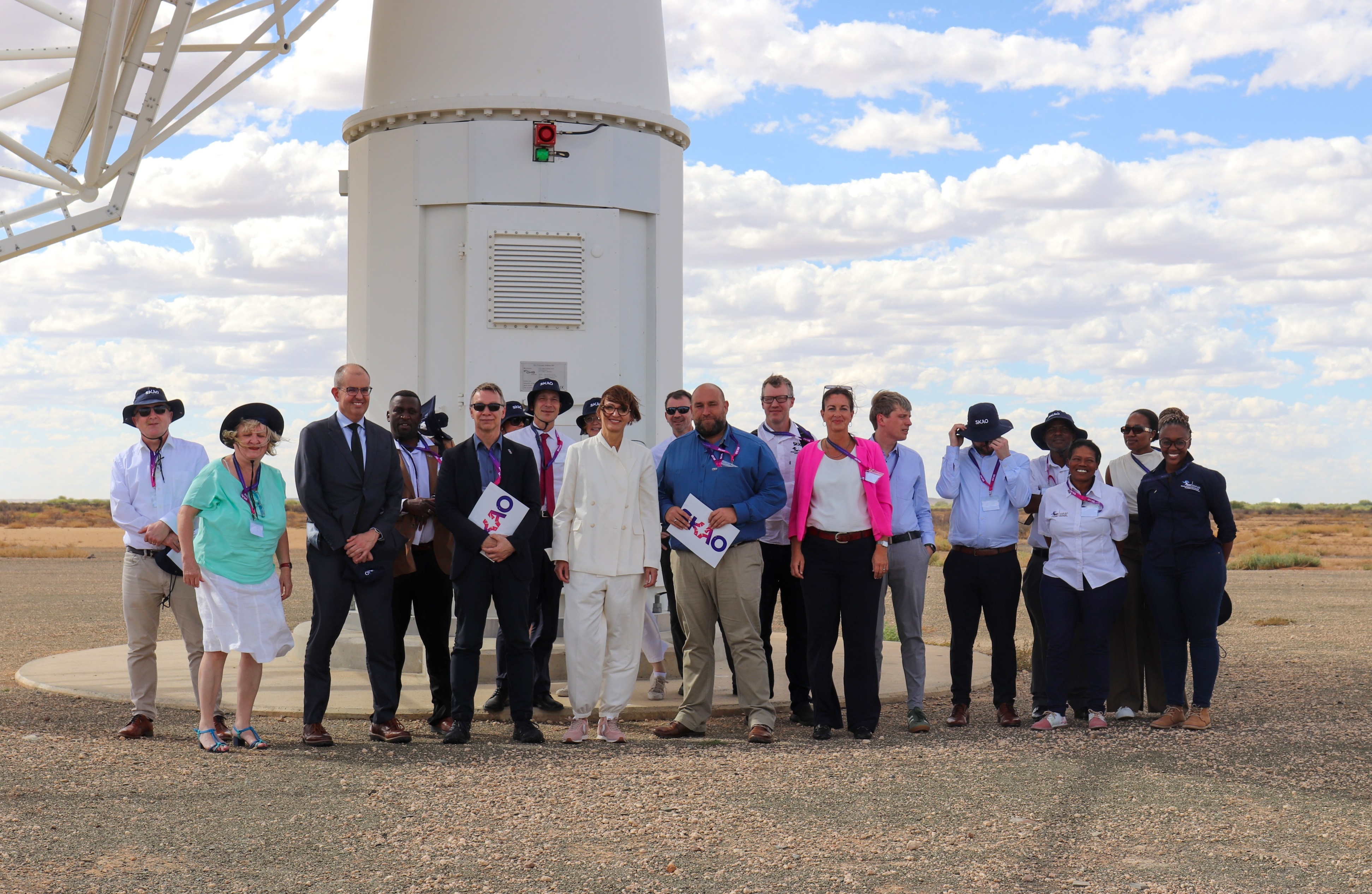
On March 28, the German Federal Research Minister Bettina Stark-Watzinger visited the Square Kilometre Array Observatory (SKAO) super telescope under construction in South Africa together with Dr Lindsay Magnus, Director of SKA-Mid in South Africa, and Prof Michael Kramer, Director at the Max-Planck Institute for Radio Astronomy (MPIfR) in Bonn. There she announced that Germany had joined the international SKAO project. The Association for Data-Intensive Radio Astronomy welcomes Germany's accession, having campaigned for many years for Germany's membership.
„With the unique super telescope SKA Observatory, we are embarking on a new era of astronomy. We want to overcome borders, both of knowledge and of countries. That is why I have decided that Germany will join the international organisation SKAO", explains the Federal Research Minister. "This will bring more than thirty years of negotiations, planning and development to a successful conclusion. And we are enabling new research and discoveries about galaxies, stars, distant planets and interstellar matter. This fuels our excellent science, but also computing, data management and STEM education. Basic research is becoming a technology driver here."
"The Max-Planck Society welcomes and supports the announcement of the Federal Ministry of Education and Research to join the SKA Observatory", adds the President of the Max-Planck Society, Prof. Martin Stratmann. "In cooperation with other German institutions and industry, the Max-Planck Society has been involved in many aspects of the SKAO - from science to technical implementation - and has once again proven that it is an internationally recognised and reliable partner. The MPG is looking forward to the next chapter of German participation in the SKAO."
"One only has to look around the SKA Mid Telescope site in South Africa to see how much the German community has already contributed to the progress of the SKA project," says Prof. Philip Diamond, Director General of the SKA Observatory. "I am thrilled that the country is seeking full membership of the SKAO to further expand its inventiveness within the community of member countries."
"I have been involved in the SKA for more than 20 years and a lot has happened in that time. For the Max-Planck Institute for Radio Astronomy and the entire radio astronomy community in Germany, German membership in the SKAO is another important milestone. Membership in the SKAO was one of the stated goals in the Astronomische Gesellschaft's memorandum "Perspectives of Astrophysics in Germany 2017-2030". This is a significant and joyful moment for all those involved", concludes Prof. Michael Kramer, Director at the MPIfR Bonn and President of the Astronomische Gesellschaft.
The Association for Data-Intensive Radio Astronomy welcomes the entry of Germany as a member of the observatory. "It is important for Germany as a science hub to give as many young researchers as possible access to SKA. Their participation in the international teams will provide us with deep insights into the mysteries of the universe," Prof. Karl Mannheim from the University of Würzburg is convinced. As chairman of the VdR, Prof. Hermann Heßling from the HTW Berlin emphasises the great potential of SKA: "High-tech innovations and further developments in the field of machine learning will make Big Data analysis and the SKA observatory even more powerful and make significant contributions to Smart Green Computing".
Artist's impression of the SKA antennas. Left: for medium frequencies (SKA-MID, South Africa); right: for low frequencies (SKA-LOW, Australia).
Photo: SKAO

Background information
The Square Kilometre Array Observatory (SKAO) enables excellent radio astronomy. The radio telescope links two sites in South Africa and Australia at a distance of over 3000 kilometres. It thus enables images in particularly high resolution. This intelligent and world-leading concept is based on successful international cooperation. It combines brilliant know-how from South Africa, Germany and other countries with the goal of outstanding science that achieves new breakthroughs in research. The telescope array will enable a new level of astronomy with new details about galaxies, stars and interstellar matter.
In addition to science, society benefits. Astronomy is an important driving force for new technological solutions - especially in the fields of engineering, optics, precision mechanics and computer sciences. As a result, astronomy also sets new accents in the education of STEM professionals.
In addition to the locations in South Africa and Australia and the headquarters in the United Kingdom, the countries China, Italy, the Netherlands, Portugal and Switzerland are also members of the SKAO. Observers are France, India, Japan, Canada, Sweden, Spain and South Korea.
The GLOW consortium, an association of leading German scientists in the field of long-wavelength radio astronomy, was an early advocate of providing access to SKAO for German scientists. At the suggestion of the Federal Ministry of Education and Research (BMBF), the Association for Data-Intensive Radio Astronomy (VdR) was founded. This association immediately took on the task of representing the national interests of the national radio astronomy. The VdR informs the public, industrial partners and other scientists about the importance of SKAO not only in the scientific context, but also for industry and future national competitiveness in the high-tech sector, and brings all stakeholders into dialogue with each other. Supporting communication between all groups involved has helped to find Germany's role in this project.
Further information
Max-Planck-Institut für Radioastronomie (MPIfR)https://www.mpifr-bonn.mpg.de/
Max-Planck-Gesellschaft (MPG)
https://www.mpg.de/de
SKA Observatory
https://www.skao.int/
South African Radio Astronomy Observatory (SARAO – SKA-MID)
https://www.sarao.ac.za/
Bundesministerium für Bildung und Forschung (BMBF)
https://www.bmbf.de/bmbf/de/home/home_node.html
Parallel press releases
Stark-Watzinger: Mit dem Superteleskop SKAO wollen wir Grenzen überwindenBMBF Press Release, 28. March 2023
https://www.bmbf.de/bmbf/shareddocs/pressemitteilungen/de/2023/03/28032023-SKAO.html
Germany announces intention to become full SKA Observatory member
SKAO Press Release, 27. March 2023
https://www.skao.int/en/news/459/germany-announces-intention-become-full-ska-observatory-member
Overcoming borders with the SKAO supertelescope
MPIfR Press Release, 29. March 2023
https://www.mpifr-bonn.mpg.de/pressreleases/2023/5
Mit dem Superteleskop Grenzen überwinden
MPG Press Release, 29. March 2023
https://www.mpg.de/20068653/mit-dem-superteleskop-skao-grenzen-ueberwinden
Contact
Representatives of the VdR:
Dr. Hans-Rainer Klöckner
+49 228 525 338
hrk@mpifr-bonn.mpg.de
Prof. Dr. Michael Kramer
+49 228 525 278
mkramer@mpifr-bonn.mpg.de
Prof. Dr. Hermann Heßling
+49 30 5019 2681
hermann.hessling@htw-berlin.de
Prof. Dr. Karl Mannheim
+49 931 31 850300
asti070@mail.uni-wuerzburg.de